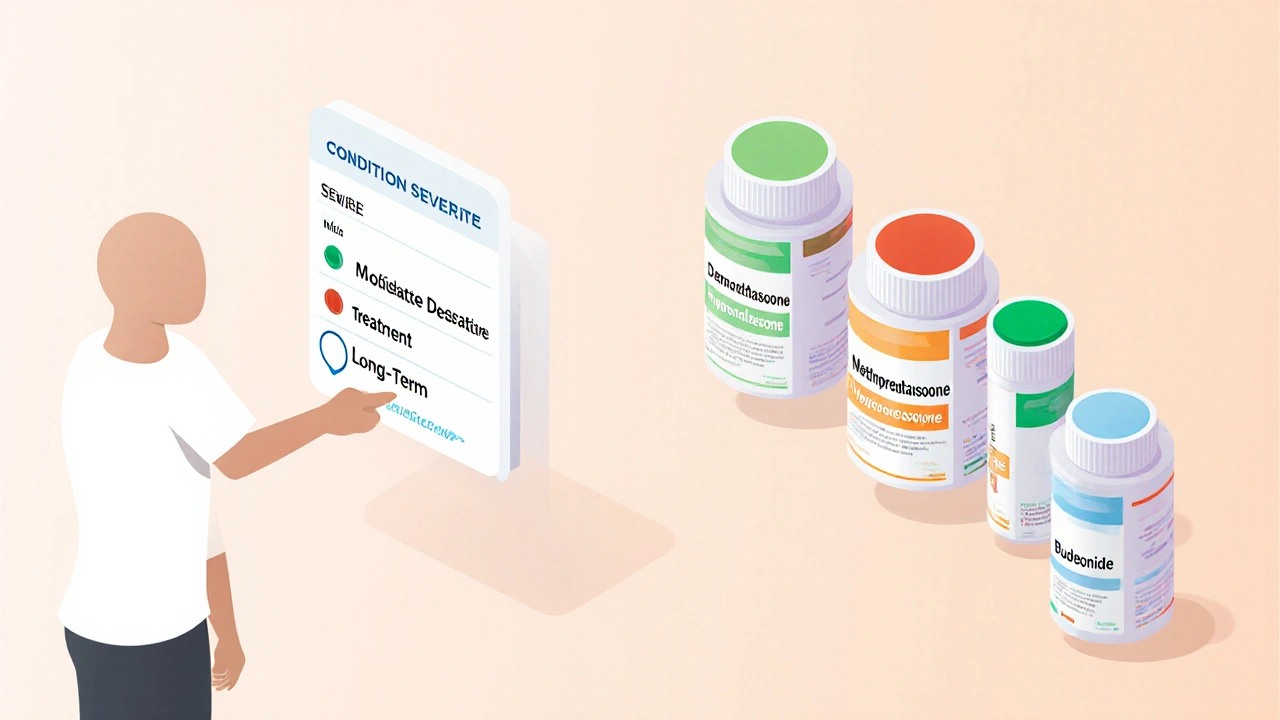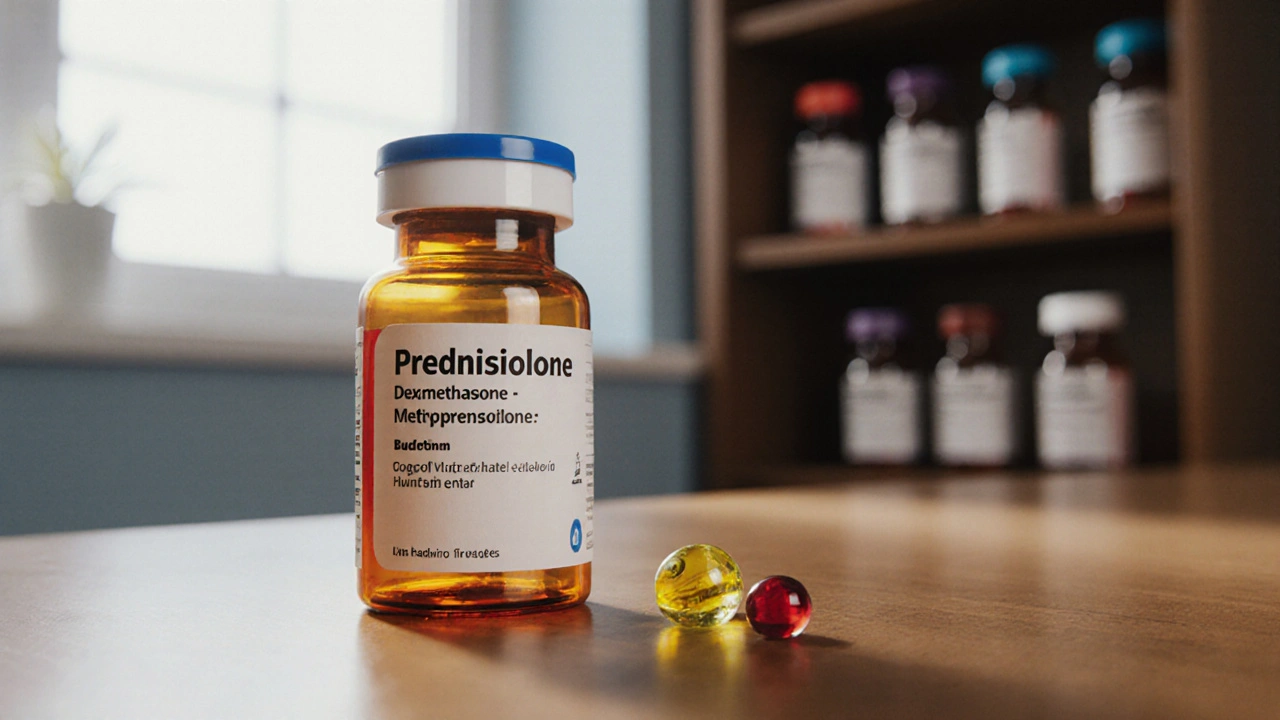Prednisolone vs Alternatives Comparison Tool
Steroid Comparison Table
| Steroid | Potency | Typical Use | Common Side Effects |
|---|---|---|---|
| Prednisolone | Medium | Inflammatory conditions, immune suppression | Mood swings, insomnia, GI irritation |
| Dexamethasone | High | Cancer treatment, severe allergies, brain swelling | Weight gain, mood changes, increased infection risk |
| Methylprednisolone | Medium | Severe inflammation, spinal cord injuries, asthma | Bone loss, fluid retention, elevated blood sugar |
| Hydrocortisone | Low | Adrenal insufficiency, mild skin conditions | Minimal, mostly localized |
| Budesonide | Low | Inflammatory bowel disease, asthma inhaler | Throat irritation, hoarseness |
Recommendation Engine
Based on your inputs:
Select condition severity and treatment duration to get personalized recommendations.
Recommended Steroid:
Why This Choice:
If you’ve been handed a bottle of prednisolone and wonder whether there’s a better fit for your condition, you’re not alone. Steroids can feel like a mystery box - powerful when used right, but risky if you miss a detail. This guide breaks down prednisolone, lines it up against the most common alternatives, and gives you a practical checklist to decide which drug matches your needs.
Key Takeaways
- Prednisolone is a medium‑potency oral corticosteroid used for inflammation and immune suppression.
- Typical alternatives include dexamethasone, methylprednisolone, hydrocortisone, and budesonide, each with distinct potency, dosing, and side‑effect profiles.
- Choosing the right steroid depends on condition severity, treatment duration, and personal risk factors such as diabetes or osteoporosis.
- Short‑term courses (<2 weeks) usually keep side effects manageable; long‑term use demands monitoring of blood sugar, bone density, and eye health.
- Never stop a corticosteroid abruptly - tapering prevents adrenal insufficiency.
Below you’ll find a quick definition of prednisolone, a snapshot of its main rivals, a side‑by‑side comparison table, and a step‑by‑step decision flow.
What Is Prednisolone?
Prednisolone is a synthetic glucocorticoid that mimics the body’s natural cortisol. It binds to glucocorticoid receptors in almost every tissue, shutting down inflammatory pathways and dampening immune responses. Doctors prescribe it for asthma attacks, allergic reactions, rheumatoid arthritis flares, and certain skin disorders.
Its potency is roughly 4‑5 times that of hydrocortisone, making it strong enough for moderate‑to‑severe inflammation but still manageable for short‑term bursts.
How Does It Work?
When prednisolone enters a cell, it travels to the nucleus and flips genes on or off. The net result: reduced production of prostaglandins, cytokines, and other inflammatory messengers. This rapid blockade explains why patients often feel relief within hours of the first dose.

Common Alternatives
Not every condition needs prednisolone’s middle‑ground strength. Here are the four most‑used substitutes, each with its own sweet spot.
Dexamethasone
Dexamethasone is a high‑potency corticosteroid (≈25‑30 times hydrocortisone). It’s the go‑to for severe cerebral edema, chemotherapy‑induced nausea, and COVID‑19‑related respiratory distress. Because it’s so strong, doctors keep the dose low and the course brief.
Methylprednisolone
Methylprednisolone sits just a notch above prednisolone in potency (≈5‑6 times hydrocortisone). It’s popular for multiple sclerosis relapses, severe allergic reactions, and post‑surgical inflammation. It can be given orally or via IV, giving flexibility in acute settings.
Hydrocortisone
Hydrocortisone is the lowest‑potency steroid on this list (essentially the same as natural cortisol). It’s often used for adrenal insufficiency, mild eczema, or as a replacement therapy when the adrenal glands can’t produce enough hormone.
Budesonide
Budesonide is a locally acting steroid, mainly delivered via inhaler or oral‑controlled‑release tablets. Its systemic absorption is low, so it’s a favorite for chronic asthma, inflammatory bowel disease, and nasal polyps when you need long‑term control with fewer whole‑body side effects.
Side‑by‑Side Comparison
| Drug | Typical Uses | Relative Potency* | Common Dose Range | Key Side Effects |
|---|---|---|---|---|
| Prednisolone | Asthma, rheumatoid arthritis, skin disorders | 4‑5× hydrocortisone | 5‑60mg/day (short‑term) | Weight gain, mood swings, elevated blood sugar |
| Dexamethasone | Severe edema, chemotherapy nausea, COVID‑19 | 25‑30× hydrocortisone | 0.5‑6mg/day | Insomnia, gastric ulcer, immunosuppression |
| Methylprednisolone | MS relapses, severe allergies, post‑op swelling | 5‑6× hydrocortisone | 4‑48mg/day | Fluid retention, acne, mood changes |
| Hydrocortisone | Adrenal insufficiency, mild eczema | 1× (baseline) | 20‑30mg/day | Low‑grade fatigue, salt‑water retention |
| Budesonide | Chronic asthma, IBD, allergic rhinitis | ≈5× hydrocortisone (systemic effect) | 200‑800µg inhaled; 3‑9mg oral | Throat irritation, oral candidiasis, rare systemic effects |
*Potency is compared to hydrocortisone, the reference glucocorticoid.
How to Pick the Right Steroid for You
- Identify the condition’s severity. Mild, localized inflammation (e.g., eczema) often responds to low‑potency drugs like hydrocortisone or budesonide. Moderate‑to‑severe systemic inflammation usually needs prednisolone or methylprednisolone.
- Consider treatment duration. If you need only a few days, higher‑potency steroids (dexamethasone) can be efficient. For weeks to months, a medium‑potency agent with a smoother taper, such as prednisolone, is safer.
- Check personal risk factors. Diabetes, hypertension, osteoporosis, or a history of psychiatric illness tilts the choice toward the lowest effective dose and the shortest course.
- Route of administration matters. Inhaled or topical budesonide limits systemic exposure, making it ideal for chronic airway or gut disease.
- Plan the taper. Stopping abruptly can cause adrenal crisis. Your doctor should outline a taper schedule that reduces the dose by about 10‑20% every few days for short courses, or weekly for longer courses.

Safety Tips and Common Side Effects
All corticosteroids share a core set of side effects because they suppress the immune system and alter metabolism. Here’s what to watch for:
- Blood sugar spikes. If you have diabetes, monitor glucose daily during the first week.
- Bone health. Prolonged use (>3weeks) can thin bones. Calcium‑vitaminD supplements and weight‑bearing exercise help.
- Mood swings & insomnia. Some people feel “wired” or unusually irritable. Discuss dose timing (morning is best) with your prescriber.
- Gastro‑intestinal irritation. Take the medication with food; consider a proton‑pump inhibitor if you have a history of ulcers.
- Eye pressure. Steroid‑induced glaucoma is rare but possible with long‑term use. An eye exam after three months is prudent.
What to Do If You Experience Problems
Never ignore persistent side effects. Here’s a quick troubleshooting flow:
- Check the dosage and timing - most issues improve when the dose is taken earlier in the day.
- Contact your healthcare provider if you notice rapid weight gain, severe mood changes, or high blood sugar.
- For skin‑related irritation, ask about a topical steroid or a brief “drug holiday” under medical supervision.
- If you’re on a long‑term plan, request a bone‑density scan and discuss preventive supplements.
Frequently Asked Questions
Can I switch from prednisolone to a milder steroid without a doctor?
No. Changing potency or stopping abruptly can trigger adrenal insufficiency. Always get a taper plan from your prescriber.
Is prednisolone safe during pregnancy?
Short courses are generally considered low risk, but high‑dose or long‑term use should be avoided unless the benefit outweighs the risk. Discuss alternatives with your obstetrician.
How quickly will I feel better after taking prednisolone?
Many patients notice symptom relief within 4-6hours, especially for inflammatory pain or allergic swelling.
What’s the biggest difference between prednisolone and dexamethasone?
Potency. Dexamethasone is roughly six times stronger than prednisolone, so doses are smaller but side‑effects can appear faster.
Can I take prednisolone with my regular blood‑pressure meds?
Usually yes, but steroids can raise blood pressure, so your doctor may adjust the antihypertensive dose during treatment.
Bottom line: prednisolone sits in the sweet spot between low‑potency hydrocortisone and high‑potency dexamethasone. Whether it’s the right choice hinges on how severe your inflammation is, how long you’ll need treatment, and what personal health factors you bring to the table. Always have a clear taper plan, track side effects, and keep an open line with your clinician.
